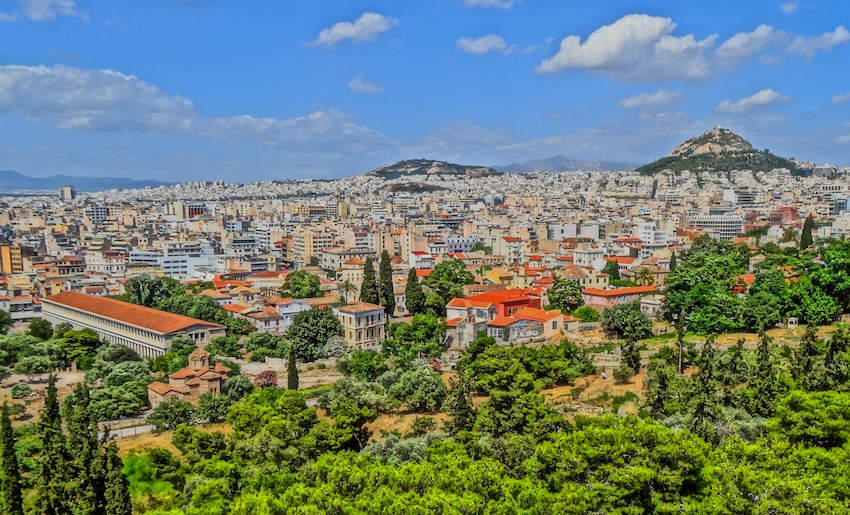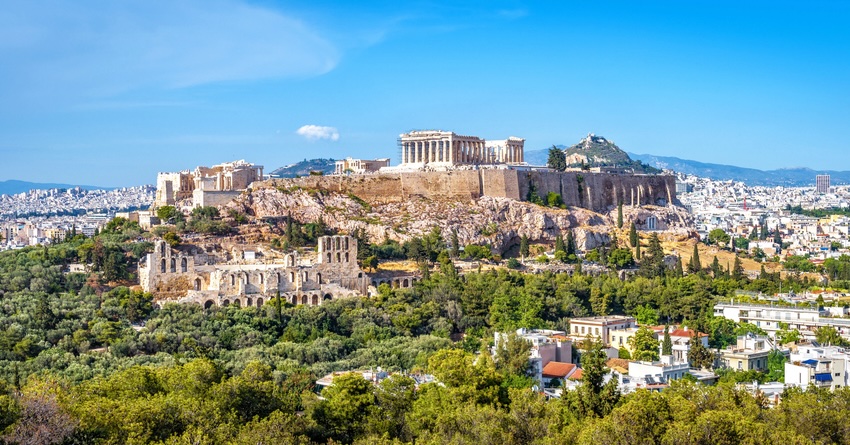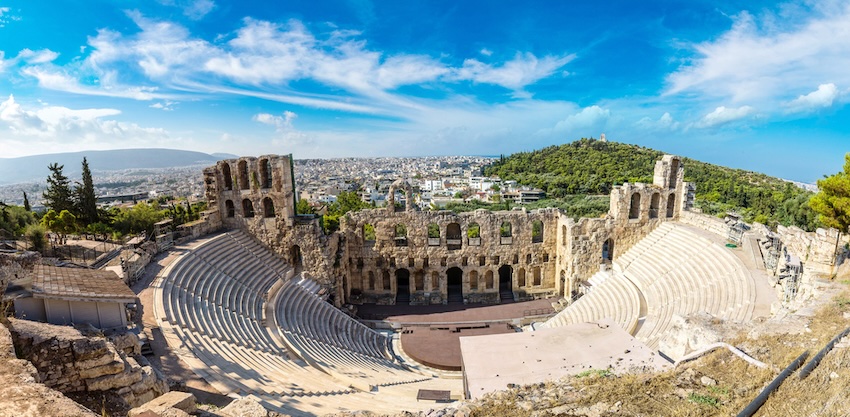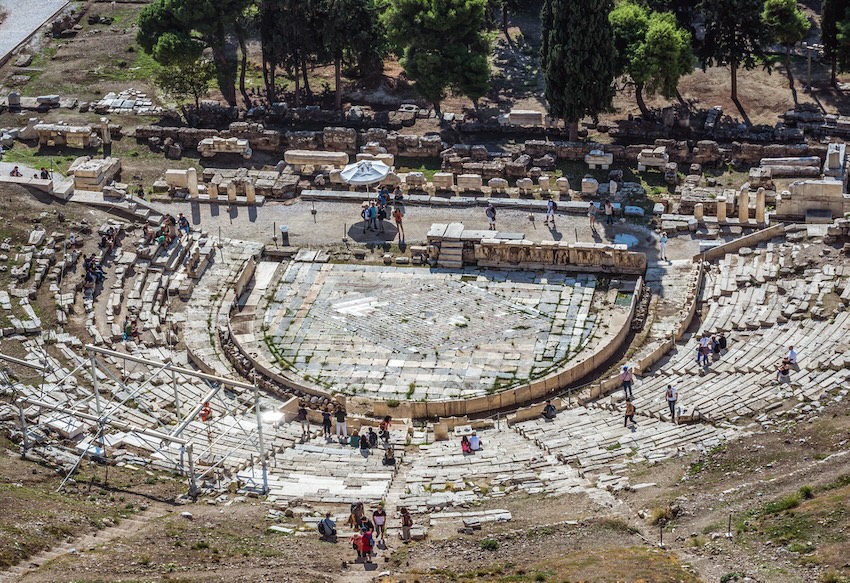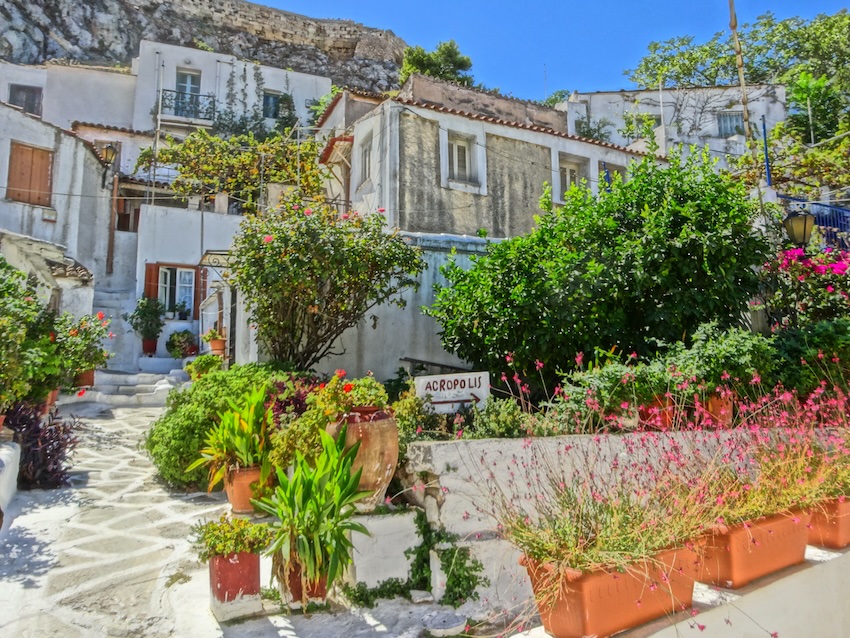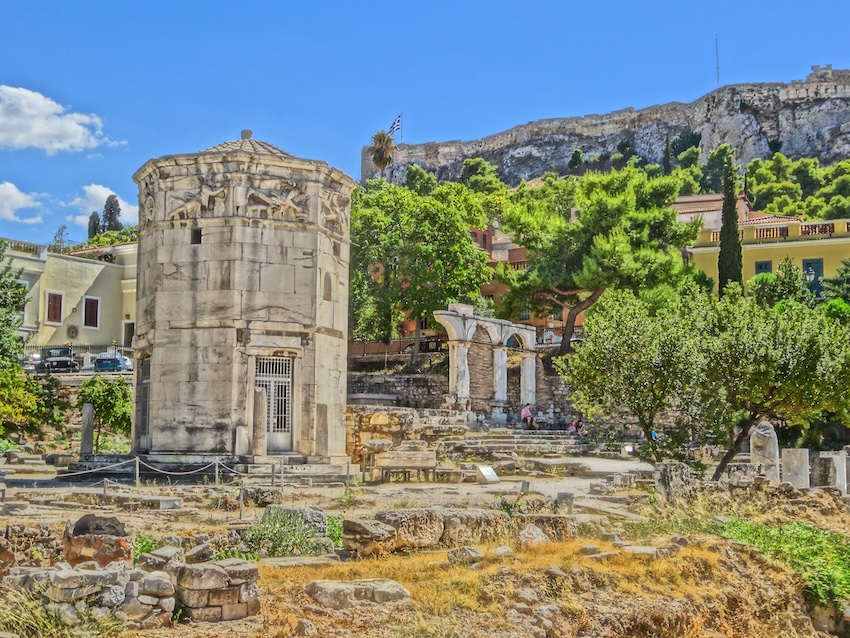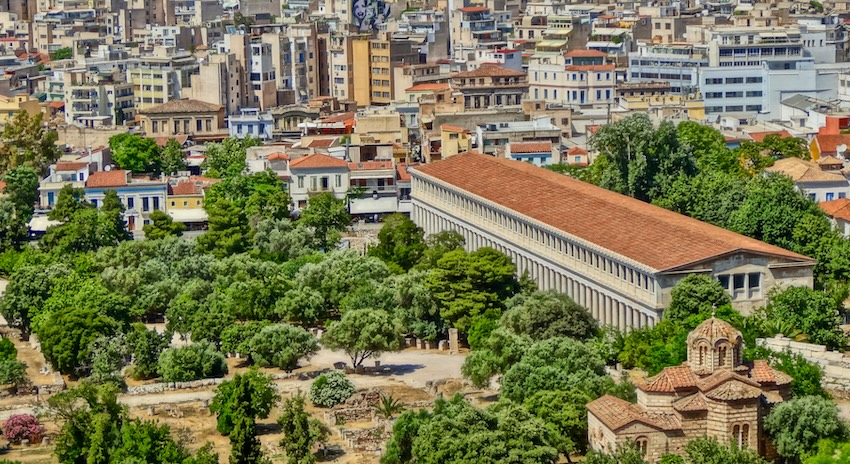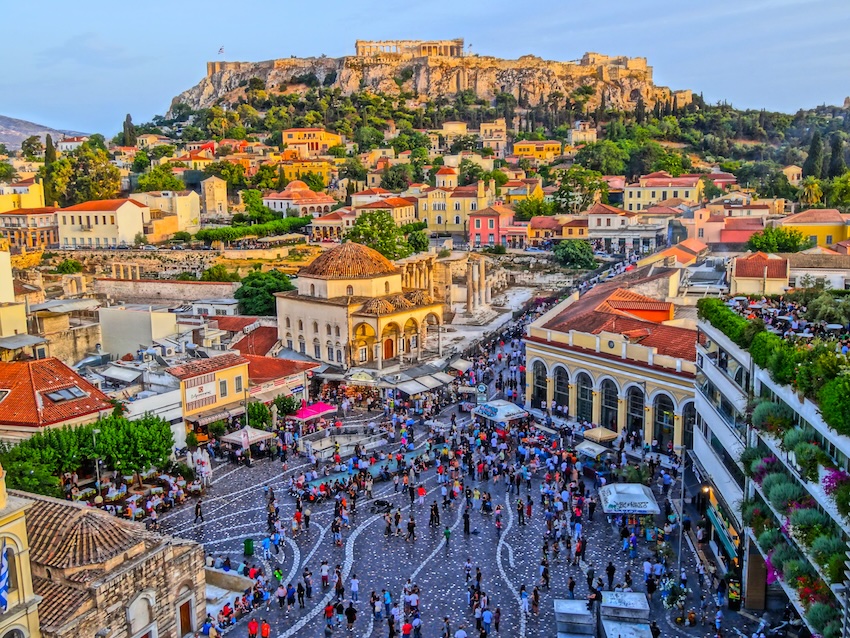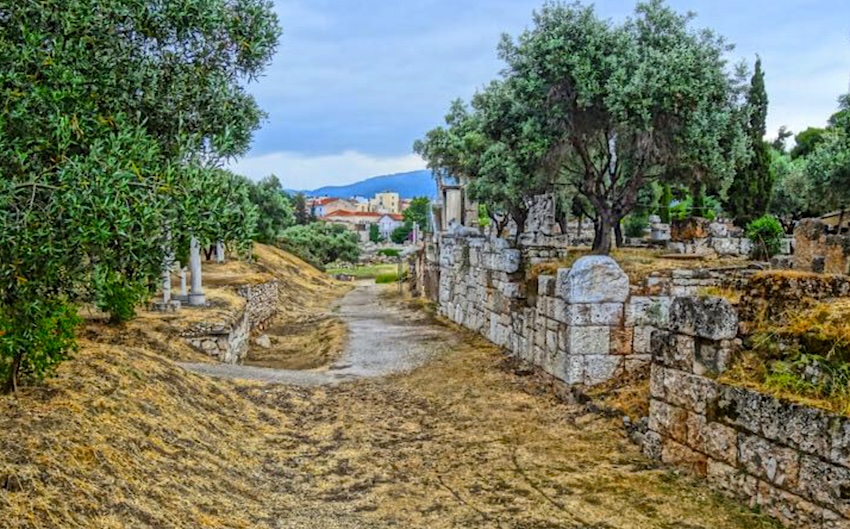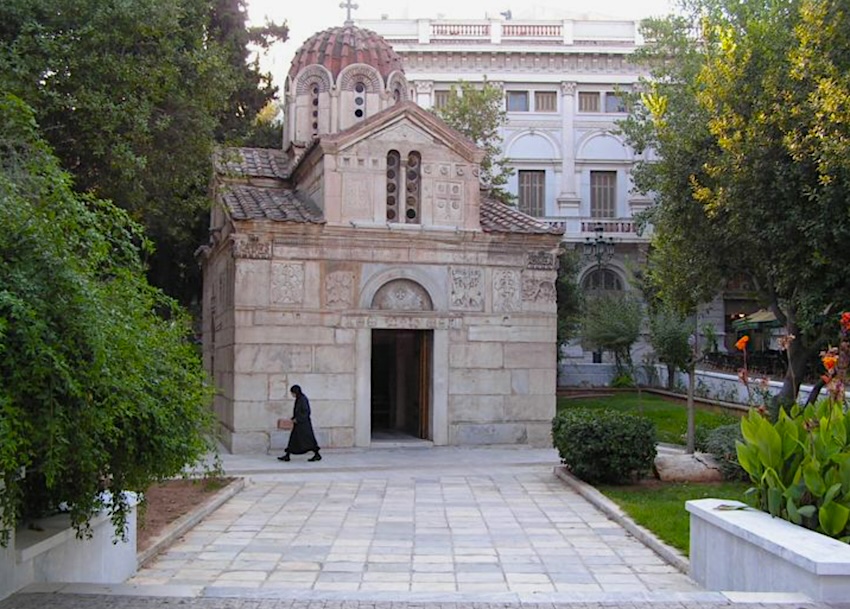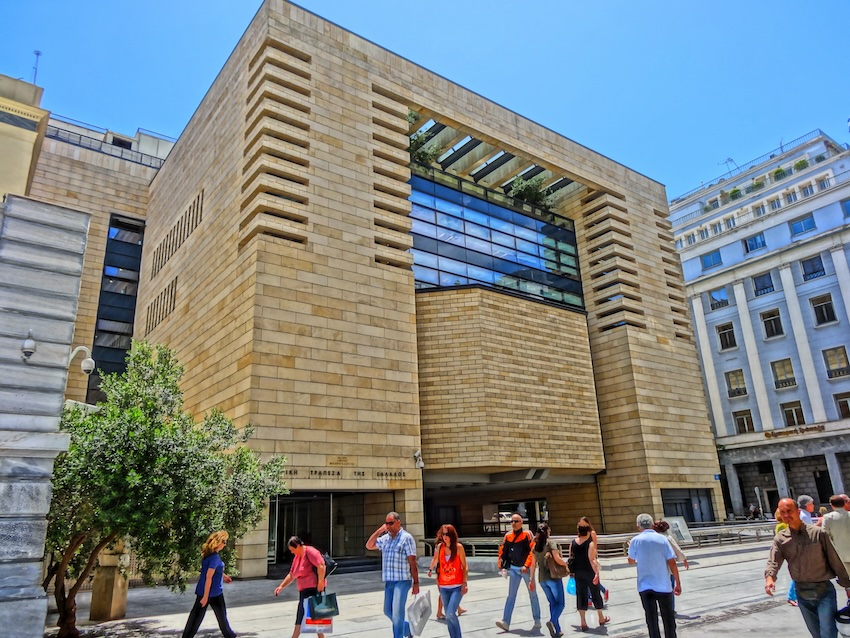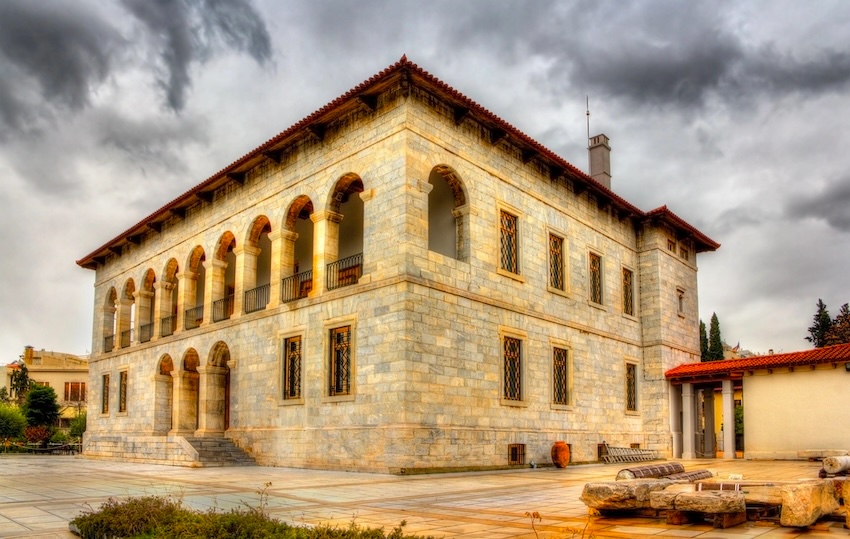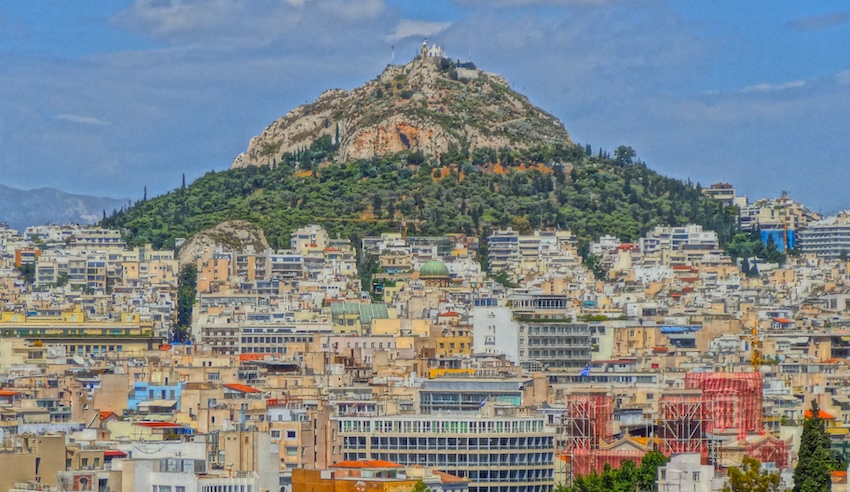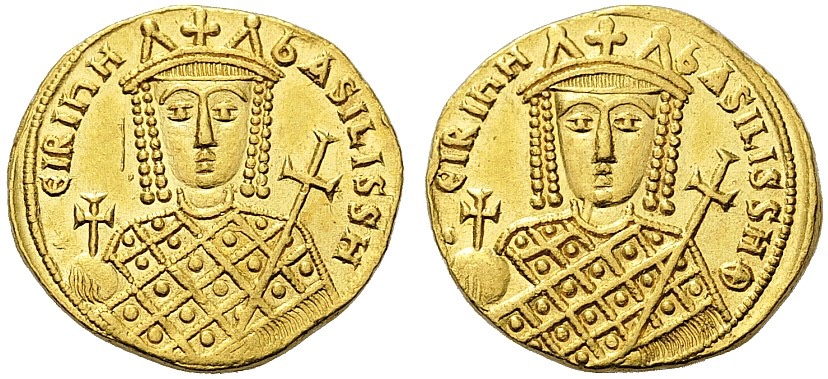
Hiking in Greece
A Byzantine Walk through Athens:
In the Footsteps of Empress Irini
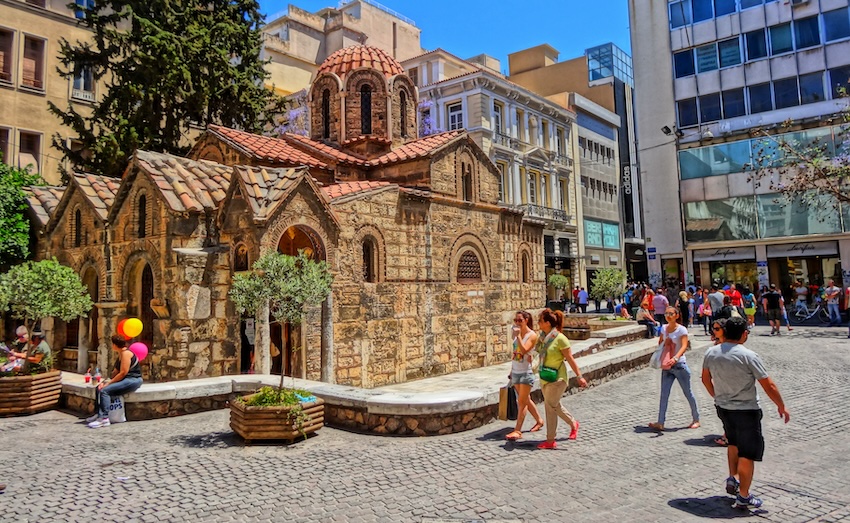
|
by Janet McGiffin In 800 AD, when Charlemagne was Emperor of the Holy Roman Empire and Harun al-Rashid was the caliph of 1001 Arabian Nights fame, a beautiful and quick-witted woman sat on the throne of the Byzantine Empire in Constantinople. Empress Irini (also Eirene, Irene) came from Athens, an orphan who grew up in the household of her Uncle Sarandapihos, commander of the theme (province) of Hellas. At seventeen, she was still unmarried—at a time when girls were betrothed at nine and wed at thirteen—so Uncle S. quickly agreed when Emperor Constantine the Fifth—a known womanizer—came through Athens inspecting the fortifications and said he was taking the stunning young woman to Constantinople to marry his son and heir, Co-emperor Leon. What happened on that Byzantine warship is unknown but it may have had something to do with the Emperor’s fate. In ten years, he and his son were both dead—suddenly and mysteriously—and so were the two Patriarchs they had appointed, leaving Irini sitting smugly on the throne as Empress and Regent for her nine-year-old son, Constantine the Sixth. There she stayed for nearly 26 years. Murderess or heroine? Plenty of Byzantine emperors grabbed the throne by sword, but Irini of Athens did it with poison—or so I claim in my four-book historical fiction, the Empress Irini series: Betrothal & Betrayal, Poison is a Woman’s Weapon, Seizing Power, and The Price of Eyes. Curious about this courageous Athenian woman? Get to know her by following her footsteps through Byzantine Athens. Step back 1,372 years to around 652 AD and walk the cobblestone lanes where Irini walked, shop where she shopped, enter the churches where she prayed, and gaze over the walls where she stood dreaming of a life beyond them. Irini probably grew up in a wealthy villa high on the north slope of the Acropolis, just below the Cyclopean Walls. Uncle Sarandapihos came from an old Athenian family and could afford a home high above the smell and noise of the Greek Agora and the Roman Agora. Her house is probably the foundation for one of the million-Euro houses that look down on tourist Plaka. |
|
|
|
From her house, Irini of Athens could climb to the Acropolis. So start your tour there. Buy your tickets to the archeological sites and hand one to the gatekeeper at the Acropolis. Climb to a spot in the shade and gaze over the Cyclopean Walls to modern Athens spread out below. When Irini was standing there, she looked over a small town inside three walls on the far edge of the Empire of the Romans of the East, with Constantinople (Istanbul) holding the power and wealth. Beyond the walls, she saw olive groves, grain fields, and grazing sheep and goats which were regularly stolen by the Slavs who attacked from the surrounding hills. The Eridanos River ran through Athens, although much of it had been channelled underground by her time. |
|
|
|
On the Acropolis, Irini saw a lot of temples with statues of gods and goddesses—and they were not white. They were still bright colors painted by the ancient Greeks, which you can see in the Acropolis Museum and National Archeological Museum of Athens. She saw the colors because the acid rain from the Mediterranean basin had not yet dimmed them, the great earthquakes had not tumbled them, and the bombings of WWII were far ahead. I believe that Irini understood the power of images because she grew up among these beautiful temples. When she became Empress, this understanding led her to reverse the ban on Christian icons and bring them back into churches and homes. Now wander over to the viewpoint at the east end of the Parthenon, the Temple of Athena. A colossal statue of Athena once stood there but Constantine the Great dragged the statue to Constantinople along with statues of Poseidon and Aphrodite. What Irini saw was a small church where the statue once stood. |
|
|
|
Exit the Acropolis and turn left around the site to find the path that leads to the upper gate of the Theatre of Dionysos, the Ancient Greek Theatre which is on your ticket. On the way, you will look down into the Herod Atticus theatre. Irini would have heard musical performances here. You can too. The price of a ticket is well spent to sit where she sat and watch the moon rise through those beautiful arches, shining over a very different Athens. |
|
|
|
Enter the Theatre of Dionysos from the upper gate and find a seat at the top of the amphitheatre. You can see all the way to the hill of Piraeus. In my story, Irini goes to a play, The Persians, about the Battle of Salamis where the Athenian army drowned the Persian navy. The Bay of Salamis may still be visible through the haze. A path at the top of the amphitheatre called the Peripatos is the ancient road leading out of Athens. Irini would have walked here often. Follow her footsteps around the Acropolis, watching for the ancient inscription on the rock and looking for the side path up to the Aglaureion which is a cave above you. Returning to the main path, exit the Peripatos, then turn right and follow the wide walkway below the Acropolis. You will pass a tiny church on the right with an interesting grotto which sits below the Erechtheion. |
|
|
|
Wind through the narrow streets of Anafiotika where the builders of the Acropolis lived, then walk down the steep lanes above the Plaka via Tripodon Street which is the oldest street in Europe, the most beautiful in ancient Athens, and connected the Theatre of Dionysos with the marketplace—the Ancient Greek Agora. Irini would have walked this street every day, passing the Monument of Lysicrates. |
|
|
|
Enter the Ancient Greek Agora with your ticket and view the Tower of the Winds which was a water clock. It isn’t known whether it functioned during her time. (You can find many other examples of ancient Greek genius at the Museum of Ancient Greek Technology on Omirou Street just up from Syntagma Square.) |
|
|
|
Visit the neighboring Roman Agora and continue on to the more open part of the Ancient Greek Agora and the Stoa of Attalus. These were busy marketplaces and residential areas in Irini’s time. She would have shopped in the Stoa, now a museum. The lovely Temple of Hephaestus was in her time a Christian church dedicated to St. George. |
|
|
|
Continue to popular Monastiraki Square where Irini shopped and visited friends. On Apollonos Street, you can view the brilliant colors of the ancient Greeks still alive in the vestments of the bishops and archbishops of the Greek Orthodox Church in the show windows of the religious supply stores. |
|
Reaching Monastiraki Square, note the basilica near Hadrian’s Wall at the corner, which history says Empress Irini built. Continue a bit down a short walk to the popular nightlife area called Psirri. The Church of Saints Anargyroi was also built by Irini, according to some historians. |
|
|
|
Now follow the lovely pedestrian walkway to Kerameikos, the archeological site of the Athens cemetery. The museum is calm, restful and interesting. Wander through the grassy grave markers and imagine how Irini must have felt when she left the open spaces of Athens to live within the walls of Constantinople with a hundred thousand citizens, not including slaves and travellers, all packed into high-rise apartments and dumping their chamber pots out the windows. |
|
Next to Keramikos was the start of the Sacred Way to the sea where the ancients practiced the “Eleusinian mysteries” at Eleusis (now Elefsina) For a thousand years until 396 AD, Athenians took part in these secret rites but the church had banned them by Irini’s time and she would have seen only abandoned temples by the sea. |
|
|
|
Return to Monastiraki Square and walk up Mitropolios Street to the Metropolitan Cathedral of Athens (Mitropoli) in Mitropoleos Square. In the southeast corner stands a tall black bronze statue of the last Byzantine emperor, Constantine XI, who disappeared when the Ottomans sacked Constantinople in 1453. Also disappeared was the famous icon of the Virgin which had protected the city. |
|
|
|
Wander across the square to the small stone church next to the cathedral. This is the Church of Panagia Gorgoepikoos, Virgin who Grants Requests Quickly. Some authorities and local tradition claim that Empress Irini had it built, or possibly restored an earlier church dated dated to 600 CE. You can see bits of marble and carvings taken from ancient shrines. When Irini was growing up, she attended many brick and stone Byzantine churches since the Byzantines were devout Christians and built churches over every ancient shrine, such as the 10th century Church of the Apostles next to the Ancient Greek Agora. Another Byzantine church is Kapnikaria on Ermou Street, found by crossing Mitropoleos Street and walking one block. Drop a coin in the box and light a candle as do many Athenians to rest both feet and soul. |
|
|
|
Athens was protected by three walls during Irini’s time. Parts can be found by walking down Ermou Street from Kapnikarea and turning right on popular Aeolou Street. Continue to Sofokleous Street (Sophacles Street) and the archaeological site showing the Wall of Themistocles under the modern looking National Bank of Greece. Or, if you are dining on Voulis Street that evening up from Metropolis Street, peer through the glass sidewalk at more wall. Or visit the lovely Benaki Museum of Islamic Art in the Kerameikos area. The wall is in the basement and the roof-top café is perfect to rest your feet and gaze at the view. |
|
|
|
Of course, visit the Byzantine Museum and the Benaki Museum on opposite sides of Vassilias Sofias Street a short walk from the Parliament Building on Syntagma Square. Imagine Irini wearing the gold and pearl earrings or dining off the silver cutlery and dishes. |
|
|
|
One day, you may decide to climb Mount Lycabetos, far from the city limits in Irini’s time. Reach St. George Lykabbetus Hotel at 2 Kleomenous Street and follow it west, bordering the park. It becomes Sarandapichou Street—Irini’s family name. |
|
Irini never returned to Athens. She named Athens as the seat of an archbishop, and she imprisoned her deceased husband’s five step-brothers in a monastery in the suburb of Halandri, say historians. We will never know, since the emperors after her erased nearly every record of Irini’s reign. All we have left of this fascinating and courageous woman is a few paragraphs written in history by a monk who knew her, and our own imaginations. |
|
|
|
Janet McGiffin is the author of the four-volume Empress Irini series about the 8th Century Byzantine Empress Irini who was one of two women to hold the throne in her own right. Janet can be reached through her website, Janetmcgiffin.com |
Help Support Matt's Greece Guides
Do you enjoy using my site? Have you found it entertaining as well as useful? If so please show your appreciation by booking hotels through the travel agencies and the links found on my Hotels of Greece site. The small commission I make on the bookings enable me to keep working and in most cases you won't find them any cheaper by searching elsewhere.
You can find
hotels in Greece by location, price, whether or not it has a swimming pool, and see photos and reviews by using this link to booking.com which also contributes to my website when you book. If you are appreciative of all the free information you get on my websites you can also send
a donation through Paypal or Venmo
Join Matt Barrett's Greece Travel Guides Group on Facebook for comments, photos and other fun stuff. If you enjoy this website please share it with your friends on Facebook and other social media.
